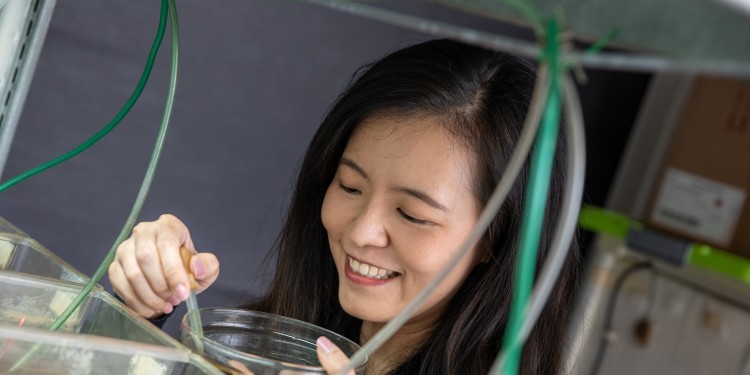
Tiny animals with surprising characteristics
When Dr. Tze Hann Ng stands in front of the transparent water tanks in the lab and points to her test objects behind the glass, any observers with an untrained eye initially see … nothing. However, after they rub their eyes and look a little more closely, a few dots can be made out in the water. And in fact these are actually crustaceans, each around just one millimetre in size, and are known as copepods. These creatures, which are probably unspectacular for most people, fascinate Tze Hann Ng. For more than a year now, at the University of Münster, she has been studying the mechanisms of the immune system of these tiny animals. Even before she came to Germany on a fellowship from the Humboldt Foundation, she was interested in aquatic creatures while working in her previous lab in Taiwan – although there she examined the larger “siblings”, shrimps and crayfish.
“We can learn a lot from these animals,” she says. By way of explanation: the immune system of invertebrates can remember an attack by pathogens – which is also an excellent property for the immune system of vertebrates such as humans. In humans, it is the so-called trained immunity which remembers pathogens by training the innate immune system. Invertebrates, however, are characterised by a phenomenon called immune priming: in their case, the innate immune system can react better to infections when it has already had contact with the same parasite. If researchers could find out more about this type of immunological specificity, this in turn would be of relevance to humans – for example, in diseases transmitted by invertebrates, such as dengue fever and malaria.
Tze Hann Ng takes one of the water containers, about ten by twenty centimetres in size, and pours some of the content into a petri dish. It can now be seen that the tiny creatures in her experiment do in fact differ in size a little because there are parents and offspring in the aquacultures. Countless generations of mini-crustaceans have more or less grown up in the working group led by Prof. Joachim Kurtz at the Institute for Evolution and Biodiversity. What cannot initially be seen with the naked eye is that the tiny animals are infected with tapeworm – a parasite which they often have to struggle against in nature, because there the copepods are the first hosts for the tapeworm before it moves on to fish and birds via the food chain.

As a biologist, her great aim is to understand the molecular mechanisms underlying the immune defence in invertebrates. “The creatures are so tiny, but the puzzle surrounding their internal mechanisms is a big one,” she says. “But one day we might find one important part of the puzzle and, in consequence, a molecule which also exists in humans and which may even tell us something about combating infectious diseases,” she adds.
But this is not the only long-term aim which Tze Hann Ng has in her research. In her lab in Taiwan, she and her colleagues had their sights set firmly on any relevance for agriculture. It is, after all, a problem if any plants or animals become infected. “The most important thing, though, is the basic research we are engaged on. Only when we know how something functions can we make use of it – regardless of whether it’s in the field of industry or medicine,” she says.
In order to come closer to the aims she has in her research, the 32-year-old junior scientist, Malaysian by birth, is helped by stays at various institutes across the world – such as her current stay at Münster University, made possible by a two-year Humboldt Research Fellowship for postdoctoral researchers. “I’m learning a lot here, and I hope I can extend my stay. In the long term, I’d like to return to Asia and, ideally, have my own professorship,” says Tze Hann Ng. But no matter where she is, she intends to remain faithful to the tiny animals with the surprising characteristics.
